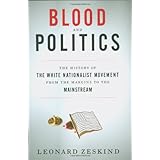
Average Reviews:

(More customer reviews)Are you looking to buy Blood and Politics: The History of the White Nationalist Movement from the Margins to the Mainstream? Here is the right place to find the great deals. we can offer discounts of up to 90% on Blood and Politics: The History of the White Nationalist Movement from the Margins to the Mainstream. Check out the link below:
>> Click Here to See Compare Prices and Get the Best Offers
Blood and Politics: The History of the White Nationalist Movement from the Margins to the Mainstream Review_Blood and Politics: The History of the White Nationalist Movement: From the Margins to the Mainstream_ (2009) by Leonard Zeskind provides an interesting history of the emerging white nationalist movement within the United States.This book considers several important types of groups within the white nationalist movement. First, it should be noted that many of the individuals described are simply gangs of armed thugs with guns. As such they differ little from black, Hispanic, or Asian gangs, or other gangs, and thus the fact that they are white is irrelevant. The more legitimate faces of white nationalism are as follows:
Willis Carto (the respectable side of the movement) who used to operate on two fronts, a lobbying front through the Liberty Lobby and a more scholarly organization the Institute for Historical Review (which I think actually raises interesting questions about war and the assignment of war guilt).
William Pierce (a neo-Nazi who rejects conservativism completely for radical race revolution, sees the holocaust as not only historical fact but as justified in terms of a "new ethic" and calls for the creation of a secret Order to administer a system of white supremacy.
David Duke (a Klansman become "respectable" who advocates a gentler approach to white nationalism featuring open debate on issues, infiltration of politics through mainstream political parties, and separatism).
Pat Buchanan (a mainstream political commentator, a staunch ultra-conservative, and an advocate of isolationist policies and immigration reform).
Several other important figures, movements, and events are discussed in this book. These include issues such as the contrast between mainstreamers versus vaguardists (who advocate violent revolution) and white supremacy versus white separatism (which the author problematically maintains are the same thing). The book discusses the following individuals and groups: Wilmot Robertson, the Order, Gordon Kahl (an early tax-protester), the Posse Commitatus, Christian Identity, Bo Gritz (and the Populist Party - which sought to appeal to dispossessed farmers), the role of Pat Robertson (who forever disgraced himself by supporting Israel and calling for the assassination of Venezuelan president Hugo Chavez on American television), Randy Weaver (and the horrifying events at Ruby Ridge - though the author despicably maintains that the government was justified), the events at Waco, the rise of the militia movement (and opposition to the New World Order), Timothy McVeigh (and the Oklahoma City Bombing, including his accomplice Terry Nichols and "others unknown"), Eric Rudolph (and anti-abortion activism), the role of the Freemen and the Phineas Priesthood (Richard Kelly Hoskins), Mark Weber (and the IHR/Legion for the Survival of Freedom, which came into conflict with Willis Carto), Resistance records (and the role of the skinhead movement), the role of German reunification and the rise of Russia, Sam Francis (and his involvement in the paleoconservative cause), the authors of _The Bell Curve_, Samuel Huntington (a mainstream academic who espoused theories of white racial unity), the role of the Reform Party in the campaign of Pat Buchanan, the scare of Y2K and other millennial fears, the rise of 9/11 conspiracy theories, the role of anti-immigration, the decline of Carto and Pierce, and finally a look towards the future. The book further considers such issues as the role of segregationism in America, opposition to income tax, communism, and immigration, the role of isolationism and nationalism, the opposition to globalism and the New World Order, and the role of pro-gun rights. The book also explains such issues as the interpretation of the Constitution by militia groups who distinguish between a "sovereign" and a Fourteenth Ammendment "citizen", the role of Christian Identity and the "one seed" versus the "two seed" theories, the role of the Phineas Priesthood based on a biblical character who allegedly opposed race-mixing, and finally the fears of "human rights" watchdog groups that the internet would introduce kids to white nationalist ideas and the subsequent hysteria which ensued. The book ends by noting the role that white nationalism may come to play in the future as the white majority becomes further dispossessed and anti-immigrant activism continues, particularly in the light of the recent election of Barak Obama.
My main criticisms of the book are as follows. I feel that the author really does not face up to the fact that multi-culturalism and "diversity" are not working very well, or the fact that some people genuinely want to be left alone and want the government out of their lives, or to consider some of the harm caused by the New Left on society since the Sixties. Further, the author makes no attempt to show why black nationalism or Jewish nationalism are any different from white nationalism. Nor why the left wing white devil theory or the Marxist capitalist devil theory are legitimate but the right wing communist devil theory or Jew devil theory are not. Finally, it is apparent that the author cannot abide the fact that whites may simply want their own counter-culture or understand the motives of disaffected people who are drawn to that counter-culture.
Blood and Politics: The History of the White Nationalist Movement from the Margins to the Mainstream Overview
Want to learn more information about Blood and Politics: The History of the White Nationalist Movement from the Margins to the Mainstream?
>> Click Here to See All Customer Reviews & Ratings Now
0 comments:
Post a Comment